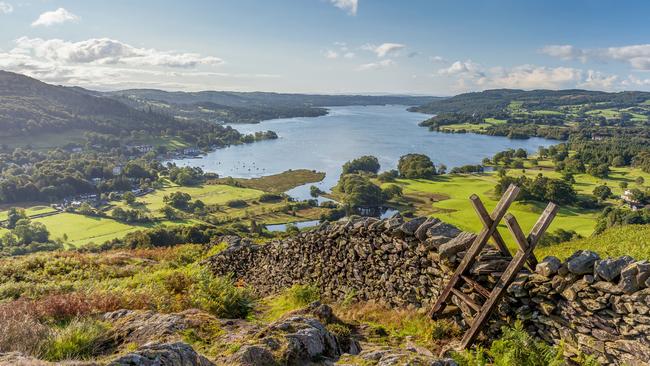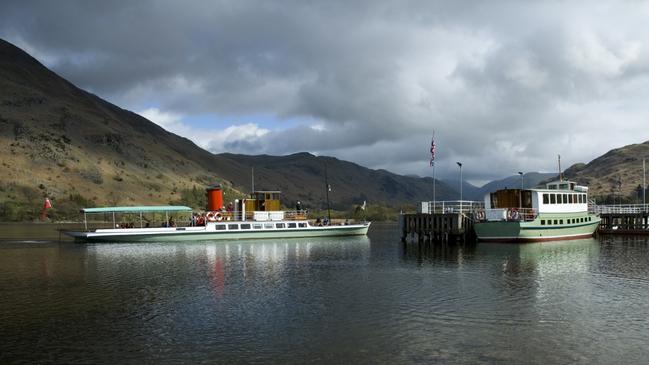Parklife: Britain celebrates national treasures
Britain is celebrating 70 years of nature worship marking the inauguration of its national parks.

I’ve never before had such serendipity on an impulse buy. Browsing the shelves of London’s palatial Waterstones bookstore, I pick up at random The Shepherd’s Life. This 2015 book by unheard-of Lake District shepherd James Rebanks became an unlikely literary hit. Its themes of cultural connection, travel, romanticism and how the stories of locals often get crushed under the weight of mass tourism provide the perfect context to a tour through Britain’s two oldest national parks.
The book is so engrossing I barely notice the passing scenery on my train journey north to Lake District National Park, in the county of Cumbria. This seriously efficient rail system whisks me painlessly from London’s Euston Station to Penrith on the other side of the country in only three hours.
It was the Lake District romantic poet William Wordsworth who first proposed in 1810 that the area should become “a sort of national property, in which every man has a right and interest who has an eye to perceive and a heart to enjoy”. And it sort of did become just that.
Rebanks rates Wordsworth’s words as prophetic, something that has shaped conservation all over the world, but as a young man he was put out by outsiders appropriating his homeland as a cure for their disconnection from nature. “How come,” he asks, “the story of our landscape wasn’t about us?”
I discuss the book with the taxi driver who drives me from Penrith Station to the tranquil Leeming House Hotel, on the shore of Ullswater. “We can call in and see if James is home now, if you like,” he says, “he lives just up this valley.”

I forgo the impromptu opportunity of a farmgate interview to instead question my driver. “So when do we enter the national park?” He chuckles and gestures out the window, where villages are disgorging schoolchildren on to the streets, sheep graze and stone walls crosshatch green hillsides. “You’re in it.”
This year is the 70th anniversary of Britain’s national parks. As I learn through a week of touring the two oldest — Peak District and Lake District, gazetted in 1949 and 1951 respectively — national parks are a different beast in Britain to anywhere else in the world.
Because every inch of the land has been thoroughly farmed, mined, churned over, altered and otherwise used for human civilisation since the time of the Vikings, there’s nothing left of what you’d call natural wilderness. But what it does have is a wealth of cultural treasures, and it’s this heritage that national parks help celebrate and protect. Whole towns (a half-million people live within national parks in England), industries and farms are located within their borders, exemplifying the quite unusual notion of a public asset in private ownership. In 2017, the Lake District National Park was declared a UNESCO World Heritage site, largely because of the way people have shaped the bucolic landscape through farming.
But none of this would have happened of course if the Lake District weren’t so utterly beautiful. Human endeavour and natural forces have created a utopia of grandeur. I get a glimpse of this from the bow of Raven, a boat in the Ullswater Steamers fleet. The company has been cruising the lake for 160 years, when its first boat, Lady of the Lake, started transporting ore from the former mining village of Glenridding to Pooley Bridge. Ullswater is supremely peaceful, something that will stick with me when later on the trip we sweep down upon the towns that dot Windermere, inundated with people shuffling shoulder to shoulder, shopping for trinkets in tourist towns.
The sun squints through clouds, bathing the high, craggy peaks in lemony shards, and stone cottages glow on the water’s edge. Most lakes in the Lake District (pedants will point out that only one — Bassenthwaite Lake — is actually called a lake, the others are waters or meres) are carved by glaciers and known as ribbon lakes. The steep, rounded mountains that line the lakes are known as fells, which, although privately farmed, have open access for all who wish to ramble upon them, and thousands do, with fell-walking being one of the most popular activities. England’s highest peak, Scafell Pike, is found here. But today some slightly flatter rambling awaits.
From Pooley Bridge, a walking track leads us through quintessentially English countryside lush with buttercups and clover, oak and ash trees, elderberry and hawthorn hedges. We follow a trickling stream, cross a turnstile and weave through a flock of Herdwick sheep, each daubed with a florescent blob of spray paint to denote ownership as it roams among other flocks. In the distance is the outline of the Pennines range, the backbone of England. I can’t describe how much I love this little summer jaunt, nor can I explain exactly why but it feels as if I’m part of an honourable tradition. In a sense I am: free passage through the countryside is one thing the national parks movement fought hard to win, and it’s a cherished right.
There’s something wonderfully British in the understated appeal of its national parks. Serengeti may have its wildebeest migration, Yosemite its giant sequoias, Hawaii its glowing volcanoes, but only the Lake District can boast the Grasmere Gingerbread Shop. This tiny church cottage home has hardly changed since 1854, when Sarah Nelson perfected her recipe for gingerbread and started selling it outside the front door on a tree stump to tourists who came to visit the graves in the church courtyard (Wordsworth is buried here). I’ve never tasted gingerbread quite like it — a cross between a biscuit and a cake, with a chewy, soft centre. The recipe is the same today and you can read it for yourself should you have the wherewithal to break into the Cumbrian bank vault where it’s held.
This is the sort of cultural heritage that national parks are celebrating: a business that has been running for 165 years, and that, as current owner Andrew Hunter reminds us, has survived two world wars, countless recessions and an abdication, and to this day produces a product to the original recipe.
Leaving the lakes and fells behind, we head south to Peak District National Park, entering the national park through a mosaic of drystone walls, sheep and farmers making hay while the sun shines. I’ve learned from Rebanks’s book the devastating effect rain can have on recently cut hay, reducing nourishing winter fodder to rotted, inedible slop, so this old saying takes on new meaning for me. We work off a classic English pub lunch at the Greenman Inn in Ashbourne by jumping on retro British racing bicycles from Glory Days Bikes and hitting the Tissington Trail, a 15km rail-trail that pops us out at Tissington Hall. This grand, 61-room house has been home to the same family since it was built in 1609. Our host, Sir Richard Fitzherbert, has the added distinction of owning the entire village of Tissington, which boasts nothing more than a tearoom, a pond, a holiday cottage, a butcher and a candlestick maker.
“The village works in harmony with what we’re trying to do here,” Fitzherbert says. “Keeping this wonderful heritage that we in England are so lucky to have inherited.”
On display in the village is the Derbyshire tradition of well-dressing, where wells are decorated with elaborate designs created only from organic materials such as flowers, bark, nuts and berries. I feel a particular attachment to a well-dressing commemorating the 70th anniversary of Britain’s national parks, with its depiction of hikers crossing a stream, wearing pants of petals and tiny stone shoes. It’s simply wonderful.
For a keepsake we visit the Treak Cliff Cavern in Castleton and shimmy through underground caves to dig for Blue John, a rare stone found only in Derbyshire. It’s seriously muddy work hacking away at the limestone with pick axes.
Back inside we’re guided through the process of cutting, waxing and polishing our stone, and the end result is much more than semiprecious to me; it’s an authentic, beautiful treasure, made all the more special because I dug it out myself.
We end the trip where it all started. From the summit of Mam Tor, a prominent peak crowned by a late Bronze Age/early Iron Age hill fort, we look across to the flat top of Kinder Scout, the moorland plateau that rises like a loaf of sourdough above the Derbyshire moors.
It was on Kinder Scout where a mass trespass took place in 1932 by people from the surrounding industrial cities, fed up with being locked out of the countryside. Some protesters did time in jail for their efforts. But the rebellious ramblers’ act of civil disobedience was game-changing, forging the path for the creation of national parks. The hard-won right to ramble now lives in perpetuity, and we exercise it with ultimate freedom here, trotting off downhill past flocks of sheep, the Derbyshire wind gently raking their wool. Rebanks would love it.
Ricky French was a guest of Visit Britain.
-
More to the story
One experience launched to help celebrate the 70th anniversary of Britain’s national parks is a day out chasing baddies with the Windermere ranger boat. National Park Lake Rangers are charged with enforcing Windermere’s 10-knot speed limit, introduced in 2005 to protect the shoreline habitat and the tranquillity of the lake. (Ironically, the world water speed record was broken here in 1930 by Sir Henry Segrave, who died after a crash on his third attempt.) You can take the wheel and lock the radar on passing boats, as well learn about the ecology, wildlife and history of England’s largest natural lake. Ranger experiences are also available in the Peak District, Exmoor and Northumberland national parks.
In the know
England’s national parks are well served by public transport. BritRail Passes are available exclusively to overseas visitors but must be purchased before arrival in Britain. A direct train runs from Manchester to Windermere in the Lake District, and Manchester to Matlock, Buxton and Hope Valley in the Peak District. The Peak District also contains 100km of off-road cycling trails. Tour company Mountain Goat offers guided jaunts throughout the Lake District in comfortable vans and with expert commentary from experienced local drivers.

To join the conversation, please log in. Don't have an account? Register
Join the conversation, you are commenting as Logout